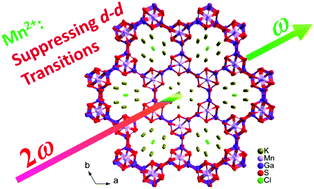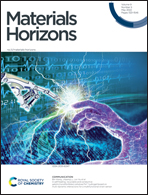Broad transparency and wide band gap achieved in a magnetic infrared nonlinear optical chalcogenide by suppressing d–d transitions†
Abstract
Magnetic infrared (IR) nonlinear optical (NLO) materials, particularly those containing d-block metals, have attracted considerable attention due to the contributions of d-orbitals to large NLO efficiency. However, the d–d transitions from the d-block metals lead to strong optical absorption and narrow band gap, seriously hindering their practical applications. The structural flexibility of salt-inclusion systems provides a good opportunity for modulating the crystal field of magnetic ions to suppress the d–d transitions but allowing the NLO-active d–s and d–p transitions. These ideas afford a new salt-inclusion sulfide [K3Cl][Mn2Ga6S12], which features a rare nanoporous [MnGa3S6]− framework with tunnels of inner diameter of 9.0 Å and possesses a broad transparency (0.39–25.0 μm) and the widest band gap (3.17 eV) among all magnetic IR NLO chalcogenides. Remarkably, it exhibits a strong phase-matchable second-harmonic generation intensity (0.8 × AgGaS2 at 1910 nm and 3.1 × AgGaS2 at 1064 nm) and a high laser-induced damage threshold (12.5 × AgGaS2 at 1064 nm), achieving the important criteria of an advanced IR NLO material.



 Please wait while we load your content...
Please wait while we load your content...